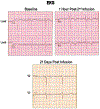Safety evaluation of a lyophilized platelet-derived hemostatic product
- PMID: 30450601
- PMCID: PMC6301028
- DOI: 10.1111/trf.14972
Safety evaluation of a lyophilized platelet-derived hemostatic product
Abstract
Background: Hemorrhage causes significant morbidity and mortality in people aged <65 years. A lyophilized platelet-derived hemostatic agent (Thrombosomes) demonstrated hemostatic efficacy in animal models. We report the results of the first safety trial of autologous Thrombosomes given to normal subjects.
Study design and methods: Ten subjects received autologous Thrombosomes prepared from their apheresis platelets, and five control subjects received a buffer solution. There were five cohorts, with three subjects per cohort (two in the Thrombosomes group and one in the control group). Doses escalated from 1/1,000 to 1/10 of a proposed efficacious dose. Cohorts 4 and 5 received the highest dose, but in Cohort 5, one-half the dose was infused 2 hours apart. Cohorts 1 through 3 were monitored for 42 days, Cohorts 4 and 5 were monitored for 60 days using hematology, coagulation, and chemistry assays and antibody testing.
Results: There were no serious adverse events (AEs) and no subject withdrawals. There were eight treatment-related AEs (TRAEs) in 5 of 15 subjects (33%) (four in the Thrombosomes group and one in the control group). Of four subjects receiving the highest doses, three had TRAEs. One had elevated D-dimer, prothrombin fragment 1 + 2, and white blood cell count (subject had concurrent upper respiratory tract infection); one had T-wave inversions in precordial leads V2 and V3 without elevated troponin or symptoms; and one had a platelet autoantibody without change in platelet count. All subjects' TRAEs resolved by Day 21.
Conclusion: There were no serious AEs in this small study. Thrombosomes were considered safe at the doses assessed. Future, larger trials will be needed to further assess safety and efficacy.
© 2018 AABB.
Conflict of interest statement
Conflict of Interest: Jeffrey Barroso, Barbara Osborne, Gayle Teramua, Esther Pellham, and Sherrill J. Slichter have disclosed no conflicts of interest.
Figures


References
-
- Berwick D, Downey A, Cornett E, et al. A National Trauma Care System: Integrating Military and Civilian Trauma Systems to Achive Zero Preventable Deaths after Injury. Washington (DC): The National Academies Press; 2016. - PubMed
-
- Peden M, MvGee K, Sharma G. The injury chart book: a graphical overview of the global overview of the global burden of injuries. Geneva: World Health Organization; 2002.
-
- Murray CJ, Lopez AD. Alternative projections of mortality and disability by cause 1990–2020: global burden of disease study. Lancet 1997;349:1498–1504. - PubMed
-
- Martin M, Oh J, Currier H, et al. An analysis of in-hospital deaths at a modern combat support hospital. J Trauma 2009;66(4 Suppl):S51–60;discussion S60–1. - PubMed
-
- Fitzpatrick GM, Cliff R, Tandon N. Thrombosomes: a platelet-derived hemostatic agent for control of noncompressible hemorrhage. Transfusion 2013;53(Suppl 1):100S–106S. - PubMed
Publication types
MeSH terms
Substances
Grants and funding
LinkOut - more resources
Full Text Sources
Other Literature Sources

